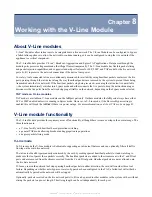
SmartNA-X
™
1G/10G User Guide 1.4
©
2015 Network Critical Solutions Limited
Chapter
9
Working with the Intelligent Packet
Processor (IPP) Module
The SmartNA-X Intelligent Packet Processor (IPP) module (model types 5701) is designed to facilitate header removal
from and payload manipulation of data packets received via multiple tunnelling protocols prior to onward processing
within the system.
Physical
The IPP module operates as a four-port 1G bps module in slots 2, 3 and 4, and a four-port 10G bps module or four-port
1G bps module in slots 1 and R (the rear slot).
No physical ports are present on the front panel – traffic flows are internal to the SmartNA-X and maps are created to and
from other ports in the system in the usual way.
There are two LEDs on the front panel: the upper one flashes to indicate traffic present on the card and the lower one
flashes to indicate a header match has been detected.
Overview of the IPP operation
The IPP module works by analysing a packet to identify specific headers. Once found these headers can be optionally
stripped from the packet or modified, leaving the rest of the packet available for further processing. Up to eight headers
can be looked for and processed per packet .
The IPP module has no external ports of its own. Instead, packets are sent to it from other SmartNA-X modules, before
being returned to the chassis for onward forwarding.
Maps are used in the normal way to direct traffic into the IPP module and then from the IPP module post processing to an
egress port to a tool. Maps can be configured using the web UI or the CLI.
In addition to header manipulation and removal, the IPP module can slice the payload to a pre-defined length before
sending the packet back into the SmartNA-X system.
It is also possible to obfuscate the payload by changing all bytes beyond a specified point to be a user defined value.
Detailed operation of the IPP module
A match (compare) is carried out on the bits in the first 120 bytes (a bit mask compare) of the packet. If a match is found,
actions can be applied to each byte within the first 120 bytes. Optionally, packets egressing from a port can be sliced to a
given length.
Matches
Match bits have a 1:1 correspondence with the bits of a packet. Bits are counted in network order from zero starting from
the first transmitted/received bit of the MAC destination address in the Ethernet header, and ignoring the preamble. Within
the field, the start bit is the first in network order, and takes the most significant bit of the value.






























